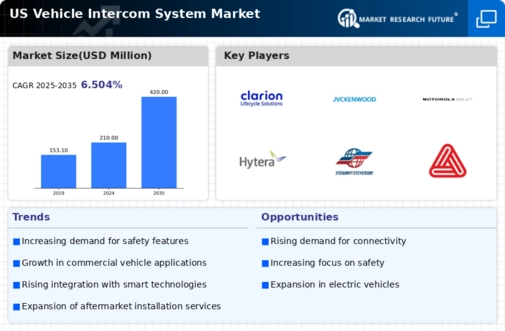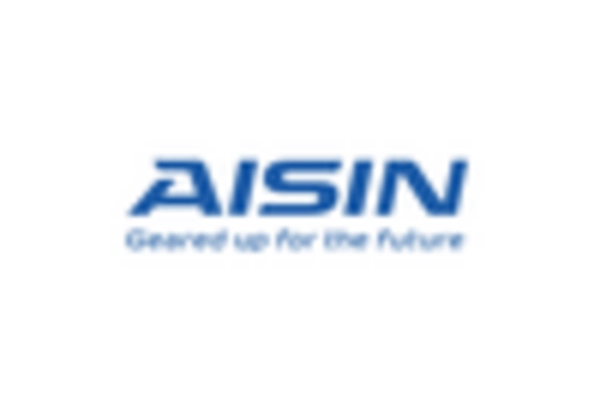Rising Demand for Enhanced Communication
The vehicle intercom-system market is experiencing a notable surge in demand for enhanced communication solutions within vehicles. This trend is driven by the increasing need for seamless communication among passengers and drivers, particularly in larger vehicles such as buses and trucks. As the transportation sector evolves, the integration of advanced intercom systems is becoming essential for operational efficiency. According to recent data, the market is projected to grow at a CAGR of approximately 8% over the next five years, indicating a robust expansion. This growth is likely fueled by the rising number of commercial vehicles and the need for effective communication in logistics and public transport. Consequently, manufacturers are focusing on developing innovative intercom solutions that cater to the specific needs of various vehicle types, thereby enhancing the overall user experience in the vehicle intercom-system market.
Regulatory Compliance and Safety Standards
Regulatory compliance and safety standards are playing a crucial role in shaping the vehicle intercom-system market. As safety regulations become more stringent, manufacturers are compelled to develop intercom systems that meet these requirements. This trend is particularly evident in commercial vehicles, where adherence to safety standards is paramount. The implementation of intercom systems can enhance communication during emergencies, thereby improving overall safety for drivers and passengers. Data suggests that the market for safety-compliant intercom systems is expected to grow by around 12% in the coming years, as companies strive to align with regulatory mandates. Consequently, the vehicle intercom-system market is likely to benefit from increased investments in safety-oriented technologies, ensuring that products not only meet but exceed regulatory expectations.
Technological Advancements in Audio Systems
Technological advancements in audio systems are significantly influencing the vehicle intercom-system market. Innovations such as noise cancellation, high-definition audio, and wireless connectivity are becoming increasingly prevalent. These advancements not only improve sound quality but also enhance user convenience, making intercom systems more appealing to consumers. The integration of Bluetooth and Wi-Fi technologies allows for hands-free communication, which is particularly advantageous for commercial drivers who require undistracted operation. Market analysis indicates that the audio technology segment is expected to account for a substantial share of the vehicle intercom-system market, with projections suggesting a growth rate of around 10% annually. As manufacturers continue to invest in research and development, the introduction of cutting-edge audio features is likely to drive further adoption of intercom systems across various vehicle categories.
Increased Focus on Fleet Management Solutions
The vehicle intercom-system market is witnessing an increased focus on fleet management solutions, driven by the growing need for efficient communication and coordination among fleet operators. As businesses seek to optimize their operations, the integration of intercom systems into fleet vehicles is becoming a strategic priority. These systems facilitate real-time communication between drivers and dispatchers, enhancing operational efficiency and safety. Recent statistics indicate that the fleet management sector is projected to grow by approximately 15% over the next few years, which is likely to positively impact the demand for vehicle intercom systems. Companies are increasingly recognizing the value of effective communication tools in reducing downtime and improving service delivery, thereby propelling the growth of the vehicle intercom-system market.
Growing Popularity of Electric and Autonomous Vehicles
The growing popularity of electric and autonomous vehicles is significantly impacting the vehicle intercom-system market. As the automotive industry shifts towards electrification and automation, the demand for advanced communication systems is likely to rise. Electric vehicles often feature sophisticated technology that requires efficient communication between various systems, while autonomous vehicles necessitate seamless interaction between passengers and the vehicle's operating system. Market forecasts indicate that the electric vehicle segment is expected to grow at a CAGR of approximately 20% over the next decade, which could drive the adoption of intercom systems designed specifically for these vehicles. As manufacturers adapt to these trends, the vehicle intercom-system market is poised for transformation, with innovative solutions catering to the unique needs of electric and autonomous vehicles.

















Leave a Comment